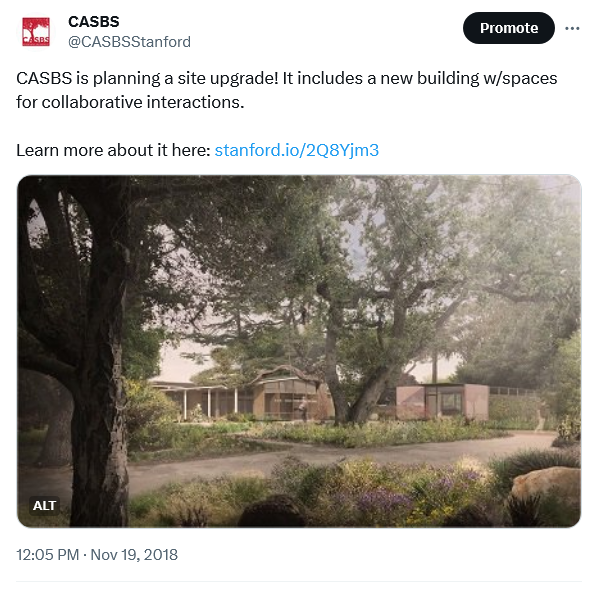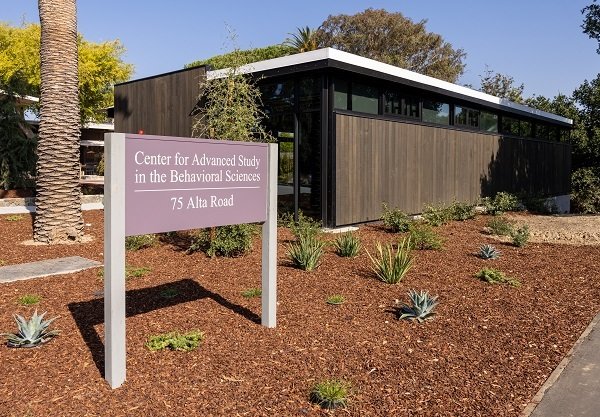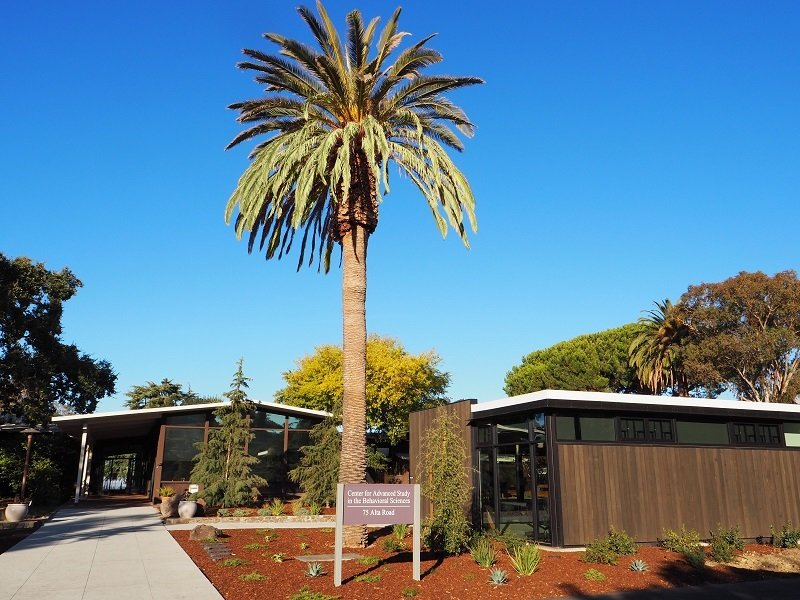A New Building on the Center's Campus
On November 9, 2023, CASBS dedicated a new building, the first to be erected on its campus since 1954, the year the Center opened.
An invitation crowd of about one-hundred people joined the CASBS staff and board of directors in the celebration, which included remarks by Sarah Soule, the Center’s current director; David Studdert, Stanford University’s Vice Provost and Dean of Research; Abby Smith Rumsey, chair of the Center’s board of directors, and Margaret Levi, the Center’s director from 2014-22. The program climaxed with a pulling from both ends of a ceremonial ribbon by Levi and Soule.
View a photo gallery of the Nov. 9, 2023, new building dedication event >
David Studdert, noting that he is as a proud social scientist, spoke of the Center as an admired intellectual destination known for its convening power and, at least in the social sciences, as “the envy of many universities and research institutes around the world.”
“It’s a place of ideas, where the best minds break new ground in the social and behavioral sciences,” Studdert said. “It’s a community of scholars, a community that gathers here to support each other in their work, but also to challenge each other. A building is just a building. But here, in this setting, it will be much more because of the people who will enter it, and the things they do here collaboratively, and the impact of those collaborations on the world and on humanity.”
A Singular Vision
Many of the remarks honored Margaret Levi. That a new building now sits in the Center’s landscape at all, allowing the Nov. 9 proceedings to occur, is a tribute to the former director’s singular vision of what the CASBS of the 21st century should be, not to mention her tireless efforts in raising the funding required to fulfill that vision. CASBS board chair Abby Smith Rumsey referred to Levi as an inspirational “north star” who “didn’t demure from her view that we actually need special spaces for special conversations.”
“This building is a perfect physical manifestation of Margaret’s vision for CASBS and the social and behavioral sciences more generally,” said Sarah Soule. “She believes that to solve the world’s grand challenges, scholars need to work in a non-traditional way. And to solve today’s systemic problems, we need systemic solutions. This building heralds a new era of interdisciplinary collaboration and discovery at CASBS. It enables us to further realize our mission of leveraging interdisciplinary research in service of solutions for some of the world’s most vexing challenges.”

And why is it a new era? In short, when the Center was founded in the 1950s, cross-disciplinary research basically meant encouraging synergies among scholars doing individual work. The Center’s architecture reflected this. Scholars interacted with each other then retreated to their individual studies, frequently incorporating cross-disciplinary insights into their own work. To be sure, CASBS continues to nurture such pursuits and always will. But contemporary challenges require more diverse perspectives and deeper interdisciplinary engagement. Today, CASBS hosts multi-year collaborative projects and convenes teams with the aim of achieving breakthroughs that no one could achieve independently. It sorely has been in need of modern facilities that rise to the challenges and support the full range of its current activities. Moreover, its outdoor meeting spaces, while beautiful and functional for low-tech, good-weather meetings, are not enough. The new building – including three high-tech collaborative convening spaces of different sizes – satisfies these demands.
And Levi had plenty of time on the CASBS hill to think about and formulate a vision. Her history of association with the Center started in 1986 when, as a political science professor at the University of Washington, she visited to meet with a CASBS fellow – classics scholar Richard Saller, now Stanford’s interim president – to obtain insights on classical Rome relevant to a chapter in a book she was working on. During the 1993-94 academic year, Levi herself was a CASBS fellow, one of several that year collaborating on a joint project eventually published as the still-influential edited volume Analytic Narratives. The fellowship experience was quite formative, both intellectually and personally, Levi reported. A few years later, she joined the Center’s board of directors, ascending to board chair during the period that led to and included CASBS’s 2008 merger with Stanford, a dramatic shift in the institution’s trajectory. By the time she became CASBS director in 2014, she had a very clear idea of what CASBS is and could be.
“I did have a vision,” said Levi at the Nov. 9 dedication event. “But it wasn’t just about bringing social scientists together and creating collaborations and discussions and linking them with people who were actually interacting in the world, whether they be in corporations or in policy. It was also revitalizing an organization that was built in the mid-20th century and still had a lot of attributes of a mid-20th century institution. It needed to really change. It needed to really respond to the world as it is now…we had to recognize that social science had become more and more collaborative.”
“The new building is a symbol of how we were revising CASBS itself and reinvigorating it and bringing it into the 21st century,” she said.
Persistence Rewarded
Like many building projects, this one played out over a process that became more protracted than hoped or anticipated. Margaret Levi intended for the dedication to occur while she remained in the CASBS director’s chair. That didn’t happen, but not for lack of effort.
Levi wasted no time after becoming CASBS director in April 2014. Later that year, the San Francisco architecture firm EHDD conducted a feasibility study, then completed a master plan vision by May 2015. Olson Kundig, the firm ultimately selected as project architect from an array of competitive bidders, completed a programming and preliminary design report in July 2016. The firm completed successive schematic designs in July 2017 and February 2018.
These steps alone unfolded over nearly four years. But that wasn’t even the half-way point.
Gradual progress hit a hard pause in July 2019 due to external political sensitivities: fear the project would complicate and become entangled in Stanford’s complex negotiations with Santa Clara County over the university’s next General Use Permit (GUP) governing its next decade or two of growth and development. Eventually, those concerns were resolved, clearing a path and leading to the March 2020 submission for formal Architectural and Site Approval (ASA). Its review, occurring during the haze of pandemic lockdown, took 16 months. The ASA was approved in July 2021, paving the way for the Center’s permit submittals in February 2022. A requisite demolition permit was granted in June 2022, so that two old barns on the CASBS property could be demolished. This satisfied a Stanford University imperative that no new net square footage be allotted to CASBS in the building of the structure; an equal or greater amount of square footage elsewhere on the Center’s property first had to be removed.

Finally, a permit for actual building was approved in August 2022. Some land was excavated, a palm tree was relocated away from the new building’s footprint (and now resides close to the Center’s front entrance), then, at long last, actual construction commenced. The construction took about one year – as staff occupying offices within earshot of the construction noise will tell you – with final inspection sign-offs in October 2023.
Nine years had begotten what, in the grand scheme of things, is a modest building of 1,701 square feet.
The foregoing mercifully glosses over a seemingly endless stream of meetings and bureaucratic process and more meetings and hurdles over the project’s life course, testing the endurance and patience of Levi and others along the way. The nine-year odyssey prompted CASBS board chair Abby Smith Rumsey, in her Nov. 9 remarks to note, in a discernible tone of dry sarcasm, that “the building was started under Margaret’s leadership, under her vision, and it’s quite extraordinary to me that she is still with us in order to see it completed. Because it seemed like it was never going to happen."
Gratitude
As one can imagine, when a building goes up there are a lot of people to thank. At the Nov. 9 dedication event, Sarah Soule took pains to recognize, in particular, the contributions of Mark Sarkozy, Stanford’s Director of Facilities in the Vice Provost and Dean of Research office; Stanford project managers Stacey Yuen and Paul Forti; and Stanford architects Sapna Marfatia and Naseem Baradaranfallahkhair.
Soule also called-out CASBS deputy director Sally Schroeder and facilities coordinator Manny Pulido for overseeing the project from the CABS side “with incredible grace and patience.” Levi, in her speech, lauded Schroeder as a “remarkable partner. This could not have happened without Sally.”
Along with the logistics and meetings and permits and waiting periods over the years that paved the way for construction, in parallel Margaret Levi vigorously fundraised for the building project, each calendar delay increasing construction costs and, thus, the amount to be raised. (The GUP and pandemic pauses pushed up the price tag by a cool $1 million, for example.)
This, too, took persistence. And generosity. In her remarks, Abby Smith Rumsey thanked key donors Dave Hitz, a current board member; Salar Kamangar, a previous board member; Chien Lee, a current board member; as well as William H. Neukom, a board member emeritus, and his wife, Sally; and Charles Simonyi, a noted Silicon Valley technologist and Stanford PhD.
More broadly, Rumsey thanked all CASBS board members, both of the recent past and present, for their generous commitments. Nearly 70% of the project’s support came from board members.
“This is a testament to their partnership and their way of honoring Margaret and the scholars we have here,” said Rumsey.
The Center gratefully acknowledges the following whose generosity helped make the new building a reality:
- The Annenberg Public Policy Center
- Cherry and James Banks
- Shona L. Brown and John Rohrer
- Susan E. Haviland and John Seely Brown
- The William and Flora Hewlett Foundation
- Dave Hitz
- Salar Kamangar
- The Charles and Roberta Katz Family Foundation
- John S. and James L. Knight Foundation
- Caron and Alan Lacy
- Chien Lee
- Margaret Levi and Robert Kaplan
- Sara Miller McCune
- Heather Munroe-Blum and Leonard Blum
- Sally and William H. Neukom
- Paul A. Ricci
- Valerie and John W. Rowe
Charles Simonyi

View a photo gallery from the Nov. 9, 2023, new building dedication event >
